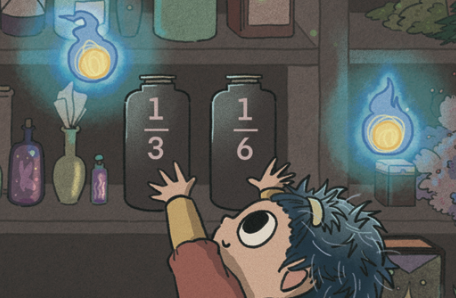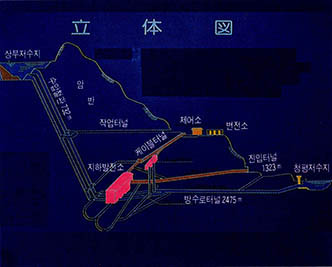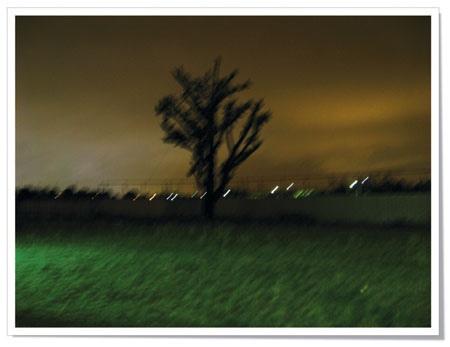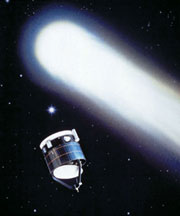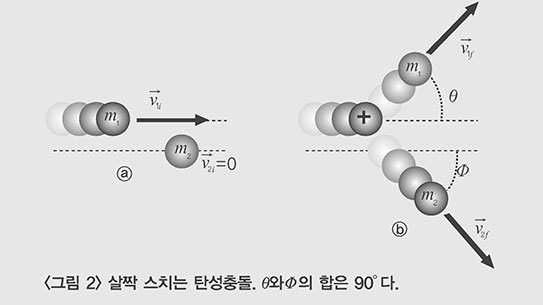아마도, 정말 아마도 우리는 화성의 표면에 유기물질이 있다는 것을 발견했는지도 모른다. 그래서 화성에 생명이 있거나 한때 있었을 수 있다는 한가닥 희망을 갖게 되었다.
1976년에 미국은 바이킹탐사기 두개를 화성표면에 설치했다. 탐사기는 화성의 흙을 떠내어 미생물이 있는지를 보여 줄 시험을 했다. 시험 가운데 몇가지는 모호했다. 과학자들은 이 실험들만 가지고는 생물이 존재하는지 그 결과가 어떤 이례적인 무생물 화학 탓인지를 말할 수 없었다.
그러나 한 시험은 흙에는 유기물질, 탄소를 포함하는 물질이 없음을 보여주는 것 같았다. 알다시피 생명은 전적으로 탄소를 포함한 물질에 바탕을 두고 있으므로 그것 없이는 생명이 있을 수 없다. 따라서 화성에는 거의 확실히 생명이 없다고 결론내렸던 것이다.
그러나 이제 과학자들은 다른 견해를 갖게 되었다. 새 탐사기가 조사를 하러 화성에 착륙하지는 않았지만 화성의 일부가 우리에게 다가온 것 같다.
그것은 이런 식으로 왔다. 지난 10년 동안 과학자들은 남극에서 운석을 주워 왔다. 세계의 대부분에서는 실제로 떨어지는 것을 보지 않는 한, 운석이 떨어졌는지를 말하기가 매우 어렵다. 일단 운석이 땅에 떨어지면 화학적으로 주의깊게 시험해 보기 전에는 여느 돌과 흡사하게 보인다. 누구든지 지구에 어질러진 모든 돌을 세밀히 화학적으로 관찰한다는 것은 극히 어려울 것이다.
그러나 거대한 남극의 만년설에는 얼음만이 있을 뿐이다. 그 위에 돌조각이 발견되면 그것은 운석으로서 놓였을 수 밖에 없다. 그 결과 과학자들은 운석으로 알고 있는 돌을 꽤 많이 모았다. 더욱이 지구 위의 다른 곳에 떨어지는 운석은 액체상태의 불로 침식되고 미생물의 공격을 받는다. 언 상태로만 물을 함유한 생명 없는 남극에서는 운석은 건드리는 사람이 없고 떨어졌을 때와 똑같이 남아 있다.
운석 가운데 몇개는 우주인들이 가져온 달의 돌과 같은 조성을 갖고 있다. 그 분화구를 만든 달의 충돌이 달 표면의 조금을 공간으로 튕겨서 지구로 날아가게 했으리라는 느낌이 든다. 몇몇 남극의 운석은 정확히 화성 대기의 조성을 가진 기체를 포함하고 있다. 이것들은 화성에서 왔을 것이라고 많은 천문학자들이 확신하고 있다.
이런 운석 하나가 작년초 이언 라이트가 이끄는 영국 천문학자 팀의 손으로 주의깊게 분석되었다. 그 속에서 소량의 두가지 다른 탄소함유화합물이 만들어졌다. 하나는 탄산칼슘 곧 석회석으로 돼 있었다. 그러나 다른 것은 유기화합물로 돼 있는데 그 정확한 본질은 확인되지 않았지만 필경 생물조직에서 발견되는 물질과 관련되어 있다.
그러므로 운석이 정말 화성에서 왔고 화성의 표면을 대표하는 것이라면 거기에는 바이킹탐사와 무관하게 유기화합물이 있음에 틀림없다. 결국 바이킹탐사기는 넓은 행성표면의 두 아주 작은 떨어진 점에 착륙했고 내린 지점이 우연히 유기물질을 포함하지 않은 곳이었을지 모른다. 그리고 화성표면에 유기물질이 있다면 아마도 매우 원시적인 어떤 형태의 생명이 지금 있거나 과거에 있었을 것이다.
그러나 설사 운석이 화성에서 왔다 해도 그것이 유기물질이 온 곳인가? 결국 화성이 그 조각을 공간으로 내보낸 충돌하는 물체의 충격을 받았기 때문에 운석은 지구에 도달했던 것이다. 충돌한 물체는 혜성이었을 수 있고 혜성은 부분적으로는 탄소함유화합물로 이루어졌다고 알려져 있다. 그 경우 운석은 화성에서 왔으나 유기물질은 혜성에서 왔는지도 모른다.
탄소는 두가지 종류, 탄소-12와 탄소-13으로 존재한다. 둘의 상대비는 지구와 혜성물질에서 조금 다르다. 어떤 천문학자들은 운석에서의 비율이 혜성에서 발견하는 것과 다르며 지구에서 기원한 것의 특징을 가졌다고 지적한다. 운석이 그것을 수집, 보존하고 마침내 분석한 과학자들이 다루는 동안 오염되었을까?
그러나 라이트와 그의 팀은 운석이 너무 주의깊게 다뤄져 오염될 수 없다고 주장한다. 만일 탄소-12, 탄소-13의 혜성기원이 틀리고 지구에서 나올 수 없었다면 그것은 탄소함유 물질이 화성에서 나왔음에 틀림없다는 추가 증거가 될 것 같다.
그러면 왜 바이킹탐사는 이런 물질을 탐지하지 못했을까? 라이트는 그것이 우연히 아니라고 주장한다. 탐사기는 화성표면 맨 위층에서 물질을 떠냈다. 그러나 화성을 때리는 혜성은 화성의 마당을 일구고 탄소함유 화합물이 집중되는 훨씬 아래로부터 지구로 번쩍이며 물질을 보낼 것이다. 그것은 꽤 재미있는 문제인데 쉽사리 해결되지는 않을 것이다.
Possibly, just possibly, we have discovered that there is organic matter in the Martian surface and, therefore, the faintest possible hope that there may be life there or that there may once have been life there.
Back in 1976, the United States placed two Viking probes on the Martian surface. The probe scooped up Martian soil and ran tests that, it was hoped, would indicate whether microscopic life was present. Several of the tests were ambiguous. Scientists could not tell. from those tests alone, whether, life was present or whether the results were due to some unusual non-life chemistry.
One of the tests, however, seemed to show there was no organic matter in the soil, no carbon-containing material. Since life, as we know it, is entirely based on carbon-containing material, there is no life without it. It was decided, therefore, that Mars was almost certainly lifeless.
But now scientists have had another look. No new probes have landed on Mars to investigate, but some of Mars may have come to us. It came about this way. In the last dozen years or so, scientists have been picking up meteorites in Antarctica. In most places in the world it is very difficult to tell whether a meteorite has fallen unless it is actually seen to fall. Once it has landed, it looks very much like an ordinary rock unless it is carefully tested chemically and it would be extremely difficult for anyone to take a close chemical look at all the rocks that litter the Earth.
On the vast Antarctica ice-cap, however, there is only ice. If any piece of rock is found upon it, it can only have been deposited there as a meteorite. As a result, scientists have now collected a considerable number of Antarctica rocks they know to be meteorites. What's more, meteorites that land almost anywhere else on Ear:th are degraded by liquìd water and invaded by microscopic life. On lifeless Antarctica, containing , water only in the frozen state, the meteorites are not touched but remain exactly as they were when they landed.
A few of the meteorites have the same composition as do the Moon rocks brought back by the astronauts. The feeling is that the bombardment of the Moon that produced its craters may have splashed some bits of the Moon's surface into space and sent them flying to Earth. A few Antarctica meteorites include bits of gas that have the precise composition of the Martian atmosphere, and these, many astronomer are convinced, may have come from Mars.
One of these meteorites was carefully analyzed earlier this year by a team of British astronomers under Ian P. Wright. In it, small amounts of two different kinds of carbon-containing compounds were formed. One consisted of bits of calcium carbonate, ordinary limestone. The other, however, consists of organic compounds, whose exact nature has not yet been identified, but which are probably related to the kind of material found in living tissue.
It follows that if the meteorite did indeed come from Mars and if it is representative of the Martian surface, then there must be organic compounds in that surface, regardless of the tests conducted by the Viking probes. After all, the Viking probes landed on two very tiny isolated points of a vast planetary surface, and they may just have landed in places that happened not to contain organic matter. And if there is organic material in the Martian surface, then some form of life, possibly very primitive, may exist there now, or may have existed in the past.
But even if the meteorite came from Mars, is that where the organic matter came from? After all, the meteorite arrived on Earth, only because Mars received the impact of a colliding body that drove pieces of Mars out into space. The colliding body may have been a comet, and comets are known to be made up, in part, of carbon-containing compounds. In that case, the meteorite may be from Mars, but the organic material may be from the comet.
Carbon exists in two varieties, carbon-12 and carbon-13. The relative proportions of the two are slightly different on Earth and in cometary materials. Some astronomers point out that the ratio in the meteorite is not what one finds in comets but is characteristic of Earthly origin. Were the meteorites contaminated, somehow, while they were being handled by the scientists who collected them, preserved them and eventually analyzed them?
Wright and his team, however, argue that the meteorite was handled too carefully to be contaminated. If the carbon-12/carbon-13 is wrong for cometary origin, and could not have arisen from the Earth, then that would seem to be further evidence that the carbon-containing material must have originated on Mars.
And why did the Viking probes not detect such material? Wright claims it wasn't chance. The probes scooped up material from the very top-Iayer surface of Mars. A comet striking Mars, however, would plow up the Martian ground and send material streaking to Earth from farther down where the carbon-containing compounds may be concentrated. It is a pretty intriguing problem, and won't easily be settled.
(c) 1989, Los Angeles Times Syndicate
이 기사의 내용이 궁금하신가요?
기사 전문을 보시려면500(500원)이 필요합니다.
1990년 02월 과학동아 정보
🎓️ 진로 추천
- 천문학
- 지구과학
- 화학·화학공학





